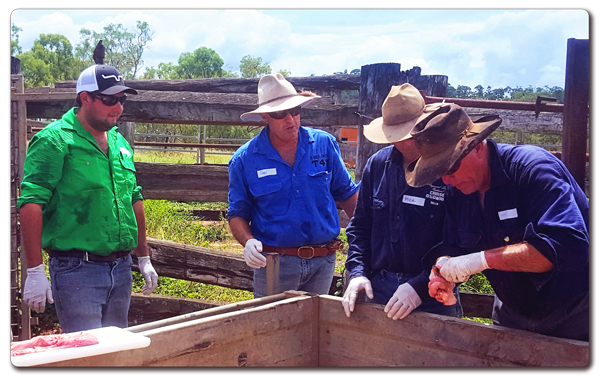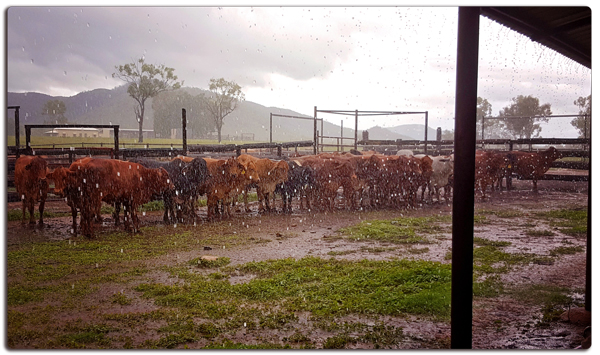Managing breeder mobs for sustainability and profitability
By putting in place a number of key management practices, northern beef producers can tighten an inefficient calving pattern into a cost-effective and profitable breeder management system.
“We now have a practical approach and refined skills to segregate our herd by pregnancy due date, and can work on improving our bottom line by targeted supplementation and reduced mustering costs,” said Kate Murphy of Gregory Springs Station, via Greenvale.
Kate, along with 48 graziers from 24 enterprises, attended a series of NQ Dry Tropics Breeder Management workshops led by specialist production vet, Dr Ian Braithwaite, from the 16th-23rd of March.

Benn Coates, Rangemore Station, Ross Tapiolas, 6 Mile Station, Mick Grant, Carse O’Gowrie Station and Dr Ian Braithwaite at the Hillsborough Station Breeder Management workshop
The importance of managing breeder mobs to get a handle on stock inventory, predict cash flow, get interest rate discounts, budget available pasture to grazing mouth/s and match infrastructure to number of cattle were among the topics discussed at the two-day workshops.
The Appleton family at Yarmina Station, the Robinson and Williams family at Hillsborough Station and the Murphy families from Clothes Peg and Gregory Springs Stations hosted the events and provided cattle.

Hillsborough Station NQ Dry Tropics Breeder Management Course welcomes rain
Key presenter Dr Ian Braithwaite is a well-known Mt Isa vet who provides pregnancy testing services to beef producers across northern Australia. Ian is passionate about the northern beef industry becoming more sustainable, with graziers integrating their herd production systems with financial and land management to make better business-wide decisions.
Dr Braithwaite said there were about 150 different factors that could impact on a grazing business, but there are five key concepts to making more money and having enough grass for cattle businesses.
“Preg-testing and aging back pregnancy is a key skill graziers can use to make a huge difference to business profitability, Ian Braithwaite said.
“Mobbing females into ideal windows of calving is a powerful tool, and one which is pretty underutilised by graziers in the north,” he said.
In contrast to the ‘bulls in, bulls out’ principle, graziers discussed controlled mating by grouping females according to three calving windows and keeping bulls in most of the year.
“This system allows graziers to accurately predict how many mouths they need to feed before the next wet season, and to make sure they have enough grass to support the herd and keep the best body condition score on females to increase reconception rates,” NQ Dry Tropics project officer Linda Anderson said.
“It’s all about making informed plans, working your cash flow and taking action before the business, grass or cows turn south,” she said.
The workshops also covered topics including bull selection, diseases affecting reproduction, ruminant nutrition, new techniques for castration and branding, and property infrastructure development and calculating carry capacity in grazing circles not paddock sizes.
“It’s important we understand that small gains across a lot of different areas in our business can add up to a large increase in profit,” said Russell Lethbridge, of Werrington Station.
This sentiment was echoed by Luke Quartermaine, Watson River Station, who singled out the small steps to increasing fertility in breeders and therefore calving percentage as key learnings from the workshop.
The mix of attendees ranged from first year jackaroos and seasoned ringers through to managers and property owners.
“It’s really important that everyone learns why certain business and production decisions are made. After all, one day these young people will be making the decisions, and the earlier they understand what keeps a business afloat and cattle producing calves and kilos of beef, the better livestock managers they will be,” Ms Anderson said
The Breeder Management courses were supported by the the National Landcare Programme and the Australian Government Saving Our Soils project through the Queensland Government Department of Environment and Heritage Protection.
“This Reef Trust funded project promotes A-class grazing management practices to reduce sediment runoff in the Burdekin region. It explores the profitability and competitiveness of grazing businesses and supports producers to adopt practice change through education, extension and implementation,” Ms Anderson said.
Main photo: NQ Dry Tropics Breeder Management Course at Clothespeg Station with Dr Ian Braithwaite.
